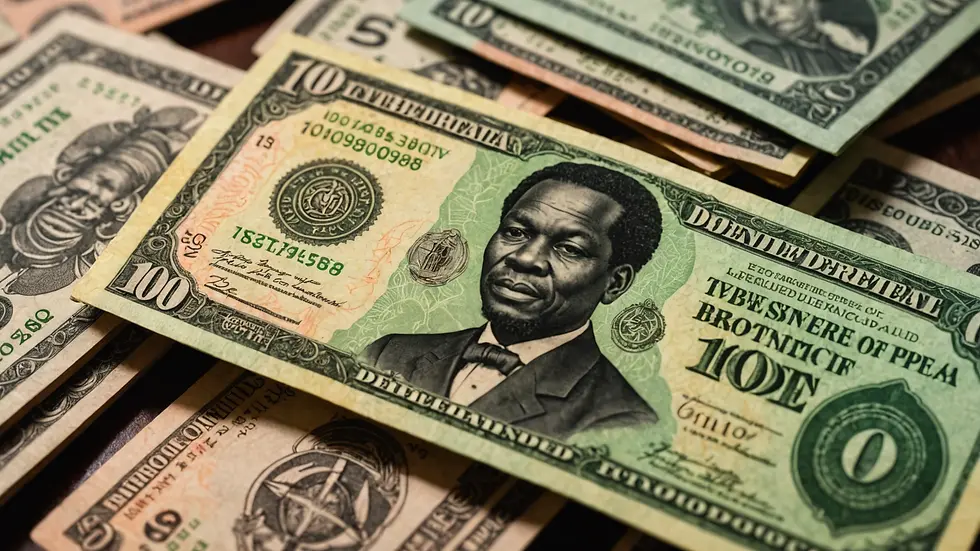The Impact of Historical Hyper-Inflation: Lessons from the Past
- Charles Griffin

- Nov 19, 2024
- 3 min read
Updated: Dec 7, 2024
Understanding hyper-inflation and its consequences is essential for grasping its effects on economies throughout history. This blog post explores notable hyper-inflationary events, emphasizing their causes and impacts on societies. We will draw out vital lessons that can help us avoid repeating the mistakes of the past.
What is Hyper-Inflation?
Hyper-inflation is a dramatic rise in prices, often exceeding 50% per month. This economic phenomenon leads to instability, reduces currency value, and causes severe and often devastating consequences for societies.
Hyper-inflation typically arises from excessive money supply, loss of confidence in a currency, and unexpected external shocks. Its impact goes beyond economic indicators and affects daily life.
Weimar Republic: Germany, 1921-1923
One of the most well-known examples of hyper-inflation occurred in Germany during the Weimar Republic. After World War I, Germany faced enormous reparations from the Treaty of Versailles, prompting the government to print money in excess.

By late 1923, the German Mark had become nearly worthless. Prices for everyday items skyrocketed. For instance, the price of a loaf of bread jumped from 250 Marks in January to 200 billion Marks by November. People faced the absurdity of needing wheelbarrows full of cash just to buy basic groceries. Savings disappeared, resulting in social unrest, a decline in trust towards government institutions, and a drop in living standards.
This example serves as a powerful reminder of the dangers posed by excessive money printing and poor economic management.
Zimbabwe: 2000-2009
Zimbabwe's hyper-inflationary period in the 2000s is among the most dramatic in modern history. Following land reforms that seized farms in the late 1990s, agricultural production plummeted. Coupled with political instability, the government turned to printing money as a solution.
In 2008, Zimbabwe's inflation rate soared to 89.7 sextillion percent per month. This collapse rendered the currency almost worthless in a matter of months. Daily transactions required bags of cash, and many resorted to bartering for food and essentials.

The devastation was extensive. Basic services crumbled, unemployment skyrocketed, and a humanitarian crisis unfolded. This period demonstrates the necessity of sound monetary policies and highlights the role political stability plays in economic health.
Yugoslavia: 1992-1994
Yugoslavia faced hyper-inflation in the early 1990s amidst war and breakup. The government printed money to fund military efforts amid economic turmoil.
By January 1994, prices doubled every 34 hours, while inflation peaked at approximately 313 million percent annually. Citizens were forced to carry large denominations to buy essential goods just to survive.

The impact on society was dire, with quality of life plummeting as the economy collapsed. This period illustrates how conflict and poor economic strategies can rapidly escalate into catastrophic hyper-inflation.
Venezuela: 2010-Present
Venezuela currently showcases a significant case of hyper-inflation. Political mismanagement, dependence on oil revenues, and sanctions have created a downward spiral. The government printed excessive amounts of money to cover debts and finance social programs.
By late 2020, inflation in Venezuela exceeded 2,900% annually, pushing many citizens into extreme poverty. Basic goods became hard to find, resulting in a mass exodus of people seeking better prospects abroad.

Venezuela's situation underscores the need for careful fiscal policies and a diversified economy. Relying heavily on a single commodity like oil can leave economies vulnerable to market fluctuations and risky governance choices.
Key Takeaways from Hyper-Inflation Events
The examples above reveal important lessons that resonate across time periods and locations.
The Dangers of Excessive Money Printing
One of the primary triggers of hyper-inflation is the reckless creation of more money. While governments may consider this an immediate solution during crises, history has repeatedly shown that the long-term consequences can be devastating, leading to economic collapse and the loss of citizens' savings.
Importance of Political Stability
Political instability often precedes hyper-inflation episodes. Effective governance is crucial for fostering public trust in currency and maintaining sound economic policies.
Economic Diversification
Heavy dependence on a single commodity, like oil in Venezuela, creates significant risk. Countries should work toward economic diversification to build resilience and develop stronger financial frameworks.
Social Impact
Hyper-inflation brings more than just economic devastation. It erodes trust in institutions and negatively affects the quality of life for individuals. These social ramifications can have long-lasting consequences.
Final Thoughts
Historical instances of hyper-inflation provide invaluable insights regarding economic dynamics. By understanding their causes and consequences, societies can take proactive measures to prevent similar crises in the future. Practical Sound Money solutions such as the Kinesis Money platform, make such proactive measures immediately accessible to a broad spectrum of the human population.
The lessons drawn from the Weimar Republic, Zimbabwe, Yugoslavia, and Venezuela stress the critical need for sound monetary policies, political stability, economic diversification, and an understanding of the broader societal impacts of poor economic decisions. With these lessons in hand, nations can strive to create more resilient economies and guard against the dangers of hyper-inflation.




Comments